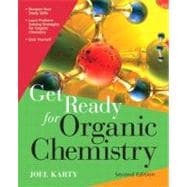
Note: Supplemental materials are not guaranteed with Rental or Used book purchases.
Purchase Benefits
What is included with this book?
| Preface | p. vi |
| Why do most Students Struggle with Organic Chemistry? | p. 1 |
| Introduction | p. 1 |
| How Organic Chemistry Is Different | p. 1 |
| The Wrong Strategy | p. 2 |
| The Right Strategy | p. 4 |
| Organization and Goals of the Book | p. 6 |
| Features of This Book | p. 7 |
| Lewis dot Structures and the Chemical Bond | p. 9 |
| Introduction | p. 11 |
| Lewis Dot Structures | p. 11 |
| Formal Charge | p. 16 |
| Resonance | p. 20 |
| Application: Drawing Lewis Structures of Complex Molecules Quickly | p. 25 |
| Application: Draw All Resonance Contributors of... | p. 27 |
| Application: Shorthand Notations | p. 36 |
| What Did You Learn? | p. 41 |
| Molecular Geometry, Dipole Moments, and Intermolecular Interactions | p. 44 |
| Introduction | p. 46 |
| VSEPR Theory and Three-Dimensional Molecular Geometry | p. 46 |
| Tetrahedral Geometry and the Dash-Wedge Notation | p. 52 |
| Rotations about Single and Double Bonds | p. 56 |
| Bond Dipoles and Polarity | p. 58 |
| Intermolecular Interactions | p. 64 |
| Application: cis and trans Isomers | p. 76 |
| Application: Melting Point and Boiling Point Determination | p. 78 |
| Application: Solubility | p. 81 |
| What Did You Learn? | p. 85 |
| Isomerism | p. 88 |
| Introduction | p. 90 |
| Isomers: A Relationship | p. 90 |
| Constitutional Isomerism | p. 91 |
| Stereoisomerism: Enantiomers and Diastereomers | p. 95 |
| Physical and Chemical Behavior of Isomers | p. 106 |
| Application: Index of Hydrogen Deficiency (Degree of Unsaturation) | p. 108 |
| Application: Draw All Constitutional Isomers of... | p. 112 |
| Application: Draw All Stereoisomers of... | p. 116 |
| What Did You Learn? | p. 120 |
| Reaction Mechanisms 1: Elementary Steps | p. 122 |
| Introduction | p. 124 |
| Bond Formation (Coordination) and Bond Breaking (Heterolysis) | p. 125 |
| Proton Transfers | p. 131 |
| Bimolecular Nucleophilic Substitution (SN2) | p. 133 |
| Nucleophilic Addition and Elimination | p. 134 |
| Electrophilic Addition and Elimination | p. 137 |
| Carbocation Rearrangements | p. 139 |
| Bimolecular Elimination (E2) | p. 140 |
| Application: Simplifying Assumptions about Electron-Rich and Electron-Poor Sites | p. 141 |
| Application: Stereochemistry of Reactions and the Production of a New Stereocenter | p. 146 |
| Application: Stereospecificity of SN2 Steps | p. 149 |
| What Have You Learned? | p. 151 |
| Charge Stability: Charge is Bad! | p. 156 |
| Introduction | p. 158 |
| Atomic Ions | p. 158 |
| Molecular Ions | p. 161 |
| Resonance Effects | p. 161 |
| Inductive Effects | p. 163 |
| Putting It All Together | p. 168 |
| Application: Strengths of Acids and Bases | p. 170 |
| Application: Strengths of Nucleophiles and the Hammond Postulate | p. 177 |
| Application: Solvent Effects on Nucleophile Strength | p. 182 |
| Application: The Best Resonance Contributor | p. 189 |
| What Did You Learn? | p. 191 |
| Reaction Mechanisms 2: SN1 and E1 Reactions and Rules of Thumb for Multistep Mechanisms | p. 193 |
| Introduction | p. 195 |
| Elementary Steps as Part of Multistep Mechanisms: SN1 and E1 Reactions | p. 195 |
| Consequences of Single-Step Versus Multistep Mechanisms | p. 200 |
| Proton Transfers as Part of Multistep Mechanisms | p. 204 |
| Molecularity of Elementary Steps | p. 210 |
| Application: Tautomerization Reactions-Neutral, Acidic, and Basic Conditions | p. 211 |
| Application: Dealing with Relatively Lengthy Mechanisms-Fischer Esterification and Imine Formation | p. 215 |
| What Did You Learn? | p. 220 |
| SN1/SN2/E1/E2 Reactions: The Whole Story | p. 224 |
| Introduction | p. 227 |
| Rate-Determining Steps: Rate Laws and the Role of the Attacking Species | p. 228 |
| Factor #1: Strength of Attacking Species | p. 232 |
| Factor #2: Concentration of Nucleophile/Base | p. 233 |
| Factor #3: Stability of the Leaving Group | p. 235 |
| Factor #4: Type of Carbon Atom Bonded to the Leaving Group | p. 237 |
| Factor #5: Solvent Effects | p. 240 |
| Substitution Versus Elimination | p. 241 |
| Sample Problems-Putting It All Together | p. 244 |
| What Did You Learn? | p. 253 |
| Concluding Remarks-What Now? | p. 256 |
| Solutions to Selected End-of-Chapter Problems | p. 258 |
| Index | p. 275 |
| Table of Contents provided by Ingram. All Rights Reserved. |
The New copy of this book will include any supplemental materials advertised. Please check the title of the book to determine if it should include any access cards, study guides, lab manuals, CDs, etc.
The Used, Rental and eBook copies of this book are not guaranteed to include any supplemental materials. Typically, only the book itself is included. This is true even if the title states it includes any access cards, study guides, lab manuals, CDs, etc.